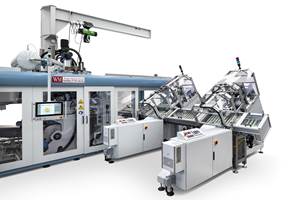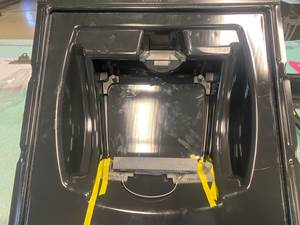Thermoformed Container Keeps Battery Cells Safe
Despite last-minute design changes and other unexpected roadblocks, thermoformer TriEnda works with a key supplier on innovative reusable shipping container.
Lithium-ion batteries are ubiquitous, used in everything from children’s toys to laptop computers. But nowhere have these common and important devices gained more ground than in an electrified vehicle (EV).
Keeping up with demand that’s projected will require significant infrastructure investment, from charging stations and upgraded electrical grids to the manufacturing lines needed to turn out millions of battery electric vehicles (BEVs) annually. And with that comes the need to safely yet cost-effectively transport huge numbers of battery cells from the manufacturer to the automaker and, years later, to a remanufacturing or recycling center.
Because the cells used to construct EV battery modules are somewhat fragile, transporting the batteries is critical to BEV adoption. It’s so critical that the United Nations has gotten involved, publishing a lengthy document titled UN Model Regulations on the Transport of Dangerous Goods, now on its 23rd revision.
These regulations provide a framework of globally recognized rules governing the shipping of hazardous materials, but it’s the UN3480 designation that keeps Jamie Noble awake at night.
Noble is the vice president of engineering at TriEnda, a leading thermoformer serving the packaging, automotive and material handling markets based in Portage, Wisconsin. The project he’s referring to is a reusable shipping container for a leading North American automotive supplier, one designed to meet the demanding UN criteria. Constructed of HDPE with a steel substructure for strength, the container is designed to support robotic loading and unloading of the 30-plus compartmentalized trays within, each carrying 15-20 relatively soft, liquid-filled battery cells for a total of 550-plus per container.

The HDPE container is designed to support robotic loading and unloading of the 30-plus compartmentalized trays within, each carrying 15-20 relatively soft, liquid-filled battery cells. Source: TriEnda
These individual cells are then assembled into modules and, from there, into a complete pack, what EV owners would see if they were to peel back the sheet metal floor and peer inside.
Noble had help on several fronts. TriEnda and its parent company, Kruger Family Industries (KFI), employ more than 800 associates in four locations across North America. Noble relied on support from his team of skilled engineers, project managers and machinists, including Jeff Haun, senior design engineer.
It was Haun who first realized the battery trays were extremely difficult to manufacture as originally specified, which called for a height tolerance of ±0.013 in. per tray. Recalls Haun, “The customer initially wanted to injection mold them from ABS, but we discovered there were only a few machines in the entire country with sufficient tonnage for that size workpiece. That’s when I suggested we thermoform them.”
The problem was that ABS is much more difficult to thermoform than HDPE. Undeterred, Haun and Noble agreed to build a prototype mold and test the process. “It worked like a charm,” Haun says. “We presented it to the customer and they liked it, especially because it ended up saving them a lot of money, never mind the fact that they would have quickly run into a roadblock if they’d gone the injection molding route.”
TriEnda then turned to longtime supplier Tooling Tech Group (TTG), Fort Laramie, Ohio, for the production tools. TTG — said to be the largest tooling provider in the U.S. — has worked with TriEnda and its sister company Penda (both part of KFI) for more than four decade. Notes Sales Manager Nate Ruhenkamp, “Our facility here specializes in thermoform tooling and has a long track record with KFI. We have a foundry in-house, which we use to create aluminum tools from — in this case, a customer-supplied pattern.”

TriEnda worked with long-time supplier Tooling Tech Group on production tool for battery cell container.
Here’s where the second hiccup occurred. Soon after delivery and testing of the production tooling, TriEnda discovered that the battery packs supplied by the OEM did not meet the original design specifications. The tooling would have to be reworked, and quickly. “Speed to market is crucial in the automotive industry,” Ruhenkamp notes. “Fortunately, it’s also something we’re very good at here.”
Noble soon told his counterparts at TTG that he would need the molds modified ASAP. Again, though, Ruhenkamp and his colleagues were well equipped to handle the unexpected request and turned the tools around within a few weeks. The molds now delivered and testing once again complete, TriEnda quickly received approval from the end customer. They’ve been in production ever since.
Many thousands of battery containers and tens of thousands of trays later (and with many thousands more still on order), Noble looks back at both teams’ accomplishments with pride.
“I would say it’s one of the longest, most profoundly challenging material handling projects we've ever worked on. Between Jeff’s ability to get ABS to thermoform within the very tight tolerance callouts, Tooling Tech’s quick response and excellent flexibility in the face of changing requirements, and other obstacles like the straight stack configuration we developed to safely and securely carry the pack’s heavy load — it was a big ask for everyone involved and quite an accomplishment overall. I'm very proud to have been part of it.”
Related Content
Automation in Thermoforming on the Rise
Equipment suppliers’ latest innovations exemplify this trend driven by factors such as labor shortages, higher-speed thermoformers and tighter quality control.
Read MoreThermoformer Maximizes Productivity with 3D Printing
Productive Plastics has created an extensive collection of 3D printed manufacturing aids that sharply reduce lead times.
Read MoreMaking Gains in the Drain Game
AWD blends extrusion and thermoforming technologies with plenty of home-brewed equipment and processes to keep water away from where it isn’t supposed to be.
Read MoreOMV Technologies Gets New CEO
Kooper brings 33 years of experience in the industrial and consumer packaging industries to OMV--the closed-loop, turnkey, inline extrusion, thermoforming and tooling systems manufacturer.
Read MoreRead Next
See Recyclers Close the Loop on Trade Show Production Scrap at NPE2024
A collaboration between show organizer PLASTICS, recycler CPR and size reduction experts WEIMA and Conair recovered and recycled all production scrap at NPE2024.
Read MorePeople 4.0 – How to Get Buy-In from Your Staff for Industry 4.0 Systems
Implementing a production monitoring system as the foundation of a ‘smart factory’ is about integrating people with new technology as much as it is about integrating machines and computers. Here are tips from a company that has gone through the process.
Read MoreMaking the Circular Economy a Reality
Driven by brand owner demands and new worldwide legislation, the entire supply chain is working toward the shift to circularity, with some evidence the circular economy has already begun.
Read More






















